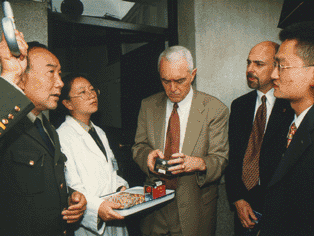The Pacific Regional Research Conference on Methamphetamine and Amphetamine-Type Stimulants, held in November in Bangkok, Thailand, explored the potential for cooperating on research to reduce and prevent the abuse of methamphetamine and other stimulants in Asian countries.
 NIDA Director Dr. Alan I. Leshner at right, spoke at the Bangkok conference along with, left to right, Dr. Suchart Laobhripart, Dr. Chatri Banchuin, and His Excellency Mr. Kamron Na Lamphun of Thailand's Ministry of Public Health.
NIDA Director Dr. Alan I. Leshner at right, spoke at the Bangkok conference along with, left to right, Dr. Suchart Laobhripart, Dr. Chatri Banchuin, and His Excellency Mr. Kamron Na Lamphun of Thailand's Ministry of Public Health.Abuse of stimulants has increased significantly in Thailand, where methamphetamine now accounts for nearly 70 percent of all addictions. "The increase in methamphetamine addiction in Thailand represents a dramatic shift. Five years ago, 70 percent of addicts were using opiates. Similar but less dramatic trends, especially among young adults, also are being reported throughout China and Southeast Asian countries," says NIDA Associate Director Dr. Timothy P. Condon.
Dr. Condon, NIDA Director Dr. Alan I. Leshner, and NIDA's Director of International Programs Dr. Patricia Needle joined representatives from Asian and Pacific countries to discuss science-based strategies for prevention and treatment, and to help identify opportunities for international research collaborations to address drug abuse issues and knowledge gaps that participating countries have in common.
NIDA-supported researchers also made scientific presentations at the conference. Dr. Patricia Case of Harvard University in Cambridge, Massachusetts, discussed patterns of methamphetamine use in the United States; Dr. David Segal of the University of California, San Diego, described neurochemical and behavioral consequences of stimulant abuse; Dr. Linda Chang of the Brookhaven National Laboratory in Upton, New York, provided an overview of techniques and findings in neuroimaging studies of methamphetamine abusers; Dr. Robert Malison of Yale University in New Haven, Connecticut, discussed genetic factors associated with methamphetamine addiction; Dr. Walter Ling of the University of California, Los Angeles, spoke about medical consequences of methamphetamine abuse; and Dr. Michael Clatts of the National Development and Research Institutes in New York City discussed the relationship between methamphetamine abuse and HIV/AIDS.
"We weren't just there to describe our scientific research," Dr.Condon says. "We found that the expertise that has been developed in the Pacific region can be highly useful in many other countries as well."
 NIDA Associate Director Dr. Timothy P. Condon (second from right) and then White House National Drug Control Policy Director Barry McCaffrey (center) discuss drug abuse treatment with staff at a 3,000-patient center in China.
NIDA Associate Director Dr. Timothy P. Condon (second from right) and then White House National Drug Control Policy Director Barry McCaffrey (center) discuss drug abuse treatment with staff at a 3,000-patient center in China.For example, the Thai government's response to HIV/AIDS over the past decade serves as a model for a concerted national approach to drug abuse, Dr. Condon notes. "Ten years ago public health officials predicted that HIV/AIDS would take a terrible toll in Thailand," he says. "The government developed an aggressive program of prevention education and public health services. Although HIV/AIDS remains a major public health problem in the country, the government's programs have influenced behavior changes and risk reduction that have measurably slowed the growth of the epidemic. This kind of approach, combined with the excellent methods that they have developed for gathering epidemiologic data, will be valuable in addressing the emerging methamphetamine problem throughout Asia."
"Early identification of these trends in drug abuse is the vital first step in responding effectively to them, and the response also must include science-based strategies for education, prevention, and treatment," Dr. Leshner says. "This conference represents an important opportunity to develop cooperative approaches to common problems."
The Bangkok conference was organized to pursue common issues that had been identified earlier in the year, when Dr. Condon joined then White House National Drug Control Policy Director Barry McCaffrey as part of a U.S. delegation that traveled to China and Southeast Asia. During that June 2000 trip, the U.S. delegation met with government leaders in China, Thailand, and Vietnam.
"In each country, we found a growing understanding of the importance of reducing the demand for drugs through prevention and treatment. In Hong Kong, for example, the government is now spending more on demand-reduction programs than on interdiction to reduce drug supply," Dr. Condon says.
In China, the delegation visited the Yunan Compulsory Treatment and Rehabilitation Center, an inpatient facility for roughly 3,000 patients. Drug abuse treatment at the center involves pharmacological detoxification, some components of behavioral therapies, and peer interaction similar to 12-step facilitation programs. Most patients are being treated for opiate addiction, but officials said methamphetamine addiction is rising in China.
